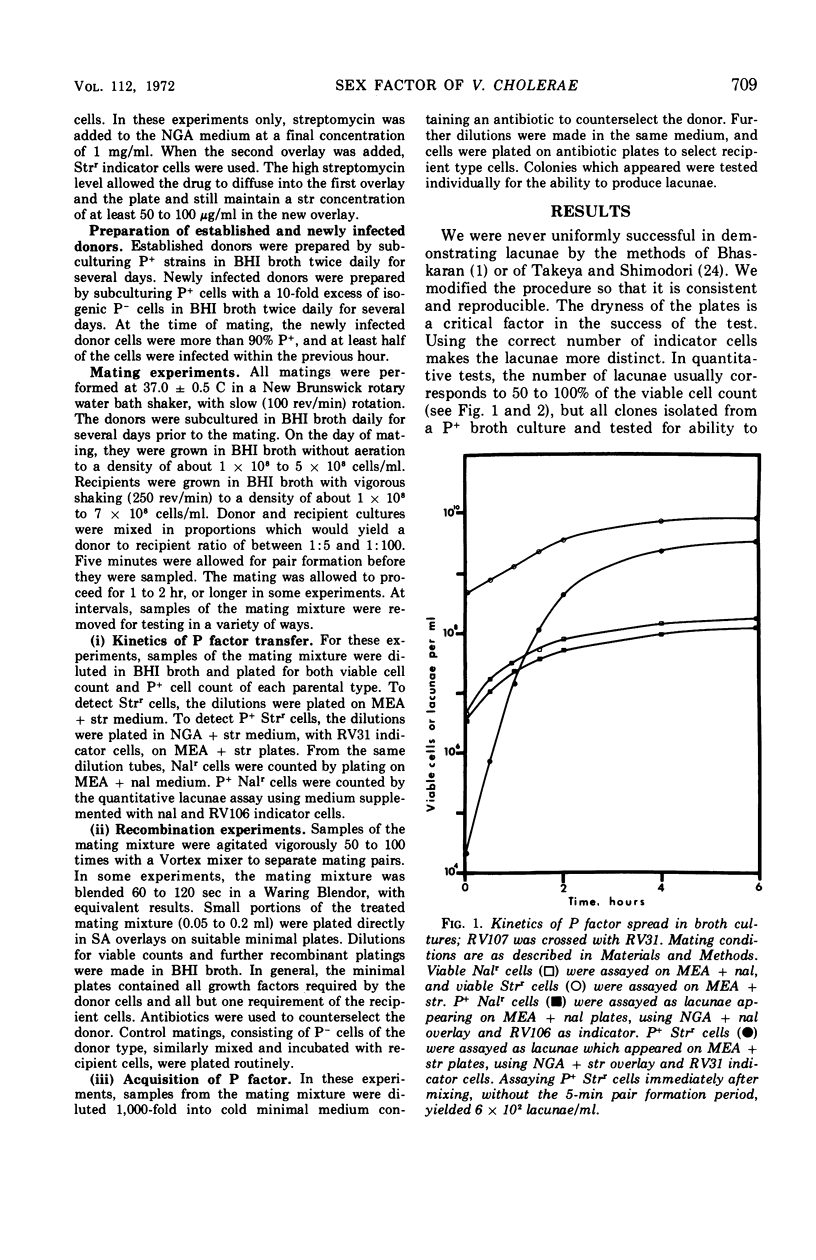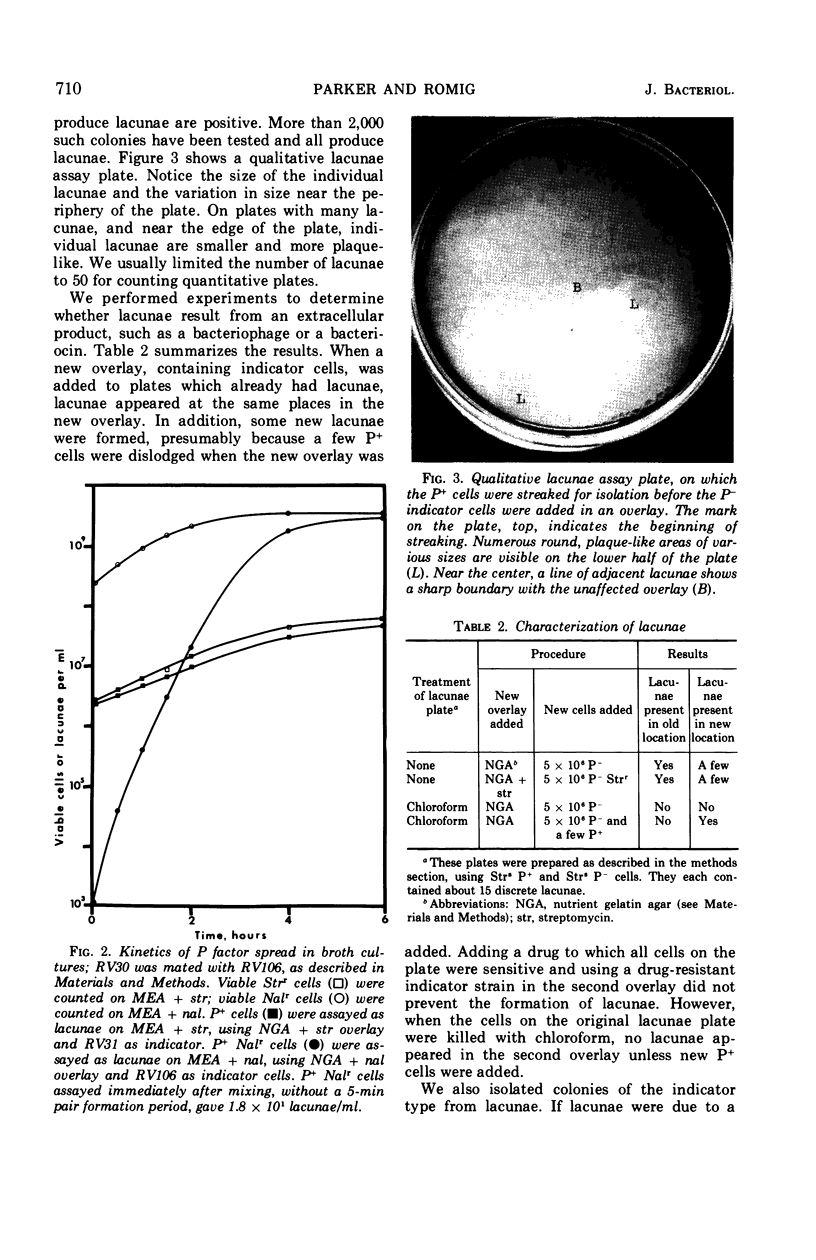Abstract
Vibrio cholerae cells, infected with the sex factor P, produce discrete, plaque-like clearings when plated on lawns of P− cells. We investigated the nature of these clearings and conclude that they are probably sites of active mating. We developed a quantitative assay for P+ cells and used it to study the kinetics of sex factor spread in broth cultures. Both established and newly infected donor populations were efficient sex factor donors, indicating that P is not self-repressed. We also investigated the kinetics of recombinant formation in broth matings. In 1-hr matings, we routinely found recombination frequencies of 10−6 per donor cell. Kinetic studies of recombinant formation showed that the markers tested all appeared at early times. Thus P, the V. cholerae sex factor, seems to resemble F in its transfer properties.
Full text
PDF







Images in this article
Selected References
These references are in PubMed. This may not be the complete list of references from this article.
- BHASKARAN K. Genetic recombination in Vibrio cholerae. J Gen Microbiol. 1958 Aug;19(1):71–75. doi: 10.1099/00221287-19-1-71. [DOI] [PubMed] [Google Scholar]
- BHASKARAN K. Observations of the nature of genetic recombination in Vibrio cholerae. Indian J Med Res. 1959 May;47(3):253–260. [PubMed] [Google Scholar]
- BHASKARAN K. Recombination of characters between mutant stocks of Vibrio cholerae, strain 162. J Gen Microbiol. 1960 Aug;23:47–54. doi: 10.1099/00221287-23-1-47. [DOI] [PubMed] [Google Scholar]
- BHASKARAN K. SEGREGATION OF GENETIC FACTORS DURING RECOMBINATION IN VIBRIO CHOLERAE, STRAIN 162. Bull World Health Organ. 1964;30:845–853. [PMC free article] [PubMed] [Google Scholar]
- Bhaskaran K., Dyer P. Y., Rogers G. E. Sex pili in Vibrio cholerae. Aust J Exp Biol Med Sci. 1969 Oct;47(5):647–650. doi: 10.1038/icb.1969.160. [DOI] [PubMed] [Google Scholar]
- Bhaskaran K., Sinha V. B. Transmissible plasmid factors and fertility inhibition in Vibrio cholerae. J Gen Microbiol. 1971 Nov;69(1):89–97. doi: 10.1099/00221287-69-1-89. [DOI] [PubMed] [Google Scholar]
- Brinton C. C., Jr The properties of sex pili, the viral nature of "conjugal" genetic transfer systems, and some possible approaches to the control of bacterial drug resistance. CRC Crit Rev Microbiol. 1971 May;1(1):105–160. doi: 10.3109/10408417109104479. [DOI] [PubMed] [Google Scholar]
- Curtiss R., 3rd, Renshaw J. F+ strains of Escherichia coli K-12 defective in Hfr formation. Genetics. 1969 Sep;63(1):7–26. doi: 10.1093/genetics/63.1.7. [DOI] [PMC free article] [PubMed] [Google Scholar]
- Demerec M., Adelberg E. A., Clark A. J., Hartman P. E. A proposal for a uniform nomenclature in bacterial genetics. Genetics. 1966 Jul;54(1):61–76. doi: 10.1093/genetics/54.1.61. [DOI] [PMC free article] [PubMed] [Google Scholar]
- ENOMOTO M., IINO T. COLONIAL DIMORPHISM IN NONMOTILE SALMONELLA. J Bacteriol. 1963 Sep;86:473–477. doi: 10.1128/jb.86.3.473-477.1963. [DOI] [PMC free article] [PubMed] [Google Scholar]
- Lacey R. W. Transfer of tetracycline-resistance between strains of Staphylococcus aureus in mixed cultures. J Gen Microbiol. 1971 Dec;69(2):229–237. doi: 10.1099/00221287-69-2-229. [DOI] [PubMed] [Google Scholar]
- NEWMAN F. S., EISENSTARK A. PHAGE-HOST RELATIONSHIPS IN VIBRIO CHOLERAE. J Infect Dis. 1964 Jun;114:217–225. doi: 10.1093/infdis/114.3.217. [DOI] [PubMed] [Google Scholar]
- Parker C., Richardson S. H., Romig W. R. Production of Bacteriophage-Associated Materials by Vibrio cholerae: Possible Correlation with Pathogenicity. Infect Immun. 1970 Apr;1(4):417–420. doi: 10.1128/iai.1.4.417-420.1970. [DOI] [PMC free article] [PubMed] [Google Scholar]
- Pierce N. F., Greenough W. B., 3rd, Carpenter C. C., Jr Vibrio cholerae enterotoxin and its mode of action. Bacteriol Rev. 1971 Mar;35(1):1–13. doi: 10.1128/br.35.1.1-13.1971. [DOI] [PMC free article] [PubMed] [Google Scholar]
- Takeya K., Shimodori S. New method for the detection of a lethal factor in vibrios. J Bacteriol. 1969 Jul;99(1):339–340. doi: 10.1128/jb.99.1.339-340.1969. [DOI] [PMC free article] [PubMed] [Google Scholar]
- WATANABE T. EPISOME-MEDIATED TRANSFER OF DRUG RESISTANCE IN ENTEROBACTERIACEAE. VI. HIGH-FREQUENCY RESISTANCE TRANSFER SYSTEM IN ESCHERICHIA COLI. J Bacteriol. 1963 Apr;85:788–794. doi: 10.1128/jb.85.4.788-794.1963. [DOI] [PMC free article] [PubMed] [Google Scholar]
- WATANABE T., FUKASAWA T. Episome-mediated transfer of drug resistance in Enterobacteriaceae IV. Interactions between resistance transfer factor and F-factor in Escherichia coli K-12. J Bacteriol. 1962 Apr;83:727–735. doi: 10.1128/jb.83.4.727-735.1962. [DOI] [PMC free article] [PubMed] [Google Scholar]



